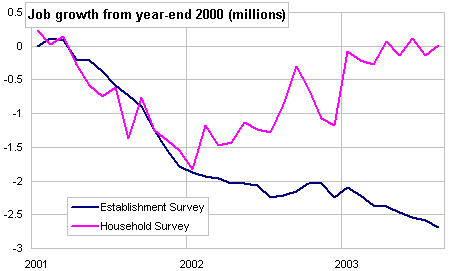You can’t open the financial pages without hearing about our “jobless recovery.” There’s no end to the hand-wringing about how gross domestic product, corporate profits and consumer spending are all moving up smartly — yet the economy seems steadily to have fewer and fewer jobs available. Oddly, at the same time we’re told the unemployment rate is falling even as there are fewer jobs, but that’s supposedly because discouraged workers have just gotten tired of even trying.
How can all these contradictory things be true at the same time? That’s simple. Maybe some are not true.
Huh? How can these official government statistics that we always hear quoted so confidently every day in the business media and by politicians not be true? Well, let’s have a look at the reality of the jobs statistics. You won’t like what you see.
When you hear (seemingly endlessly) about how “payrolls contracted this month,” or that “there are 2.7 million fewer jobs today than when President Bush took office,” you are hearing numbers from something called the Establishment Survey, put out every month by the Department of Labor’s Bureau of Labor Statistics. It’s called “Establishment” because it’s a poll of 160,000 business establishments and government agencies.
That’s right, it’s just a poll. Same as when someone knocks on your door and asks you who you’re going to vote for. These 160,000 establishments simply tell the bureaucrats at the BLS how many people are on the payroll each month. If you thought it was more accurate or complete than that, or perhaps that the BLS gets some kind of computer report on all the salaries paid all over the country, you’re wrong — big brother isn’t that big (yet).
There are all kinds of flaws — the bureaucrats call them “artifacts” — in the Establishment Survey. If someone is moonlighting and holds two jobs, he gets counted twice. Agricultural workers are left out. And so are self-employed and household workers (because the bureaucrats are only polling establishments). And most significant, brand new and smaller establishments are left out, because the bureaucrats don’t even know they exist in order to poll them.
When you hear about the “unemployment rate,” that comes from an entirely different BLS survey. This one is called the Household Survey. It’s called “Household” because, instead of polling establishments, it polls 60,000 American households. And it has plenty of its own “artifacts.” So there’s a basic reason why you could see the unemployment rate going down at the same time as the number of total jobs is contracting — it’s these two statistics are taken from two entirely different surveys, and both of them are nothing more than mere polls.
Wait — it gets worse. It turns out that the Household Survey can be used for more than just the unemployment rate. To know the unemployment rate, you have to know the number of employed people — so the Household Survey offers its own version of how many jobs there are in the economy. And what it’s telling us is that this is not a “jobless recovery” after all. According to the Household Survey, job growth in this recovery is soaring.
Take a look at this chart, which compares the two surveys’ versions of employment reality. First, while the Establishment Survey shows that all-too-familiar loss of 2.7 million jobs since year-end 2000, the Household Survey shows jobs being just about flat.

But more interesting is the fact that the two surveys tracked each other closely during the recession, but then they parted company shortly after the recession ended (according to the National Bureau of Economic Research, the recession “officially” ran from March 2001 to November 2001). Since the Household Survey’s job count bottomed out in January 2002, it’s shown 1.8 million new jobs added to the economy through last month. At the same time, though, the Establishment Survey has shown 817,000 jobs lost.
These are the statistics that we count on to tell us what economic reality is. Yet, since January 2002, the two surveys have diverged by 2.6 million jobs! So what, then, is reality? The only reality is that we don’t really know. Nobody does.
But lots of people pretend to know, of course. Most professional economists will tell you something like “Well, we’ve always used the Establishment Survey to measure jobs.” OK, so that means that at least today’s questionable statistics are comparable to history’s questionable statistics. But the statistics are all still questionable.
And the traditionalists don’t really have any definitive reason for preferring one over the other. Their typical limp defense of the Establishment Survey is that it’s more accurate than the Household Survey because it uses a larger sample — 160,000 establishments, rather than 60,000 households. But the same traditionalists are perfectly happy to use the Household Survey to calculate the unemployment rate.
To my mind, sample size is the least of the problems. I’m more concerned by the fact that the Establishment Survey completely ignores self-employment and newer and smaller businesses. Maybe that didn’t matter 50 years ago when everyone either worked for a big corporation or didn’t work at all. But in today’s dynamic economy, the creation of new businesses is the engine of growth. And more and more workers are “free agents” who operate entirely outside the corporate sphere. This is particularly evident during economic slowdowns. Surely some of the former professionals who were downsized during the last recession became independent consultants, landed real clients and were paid for their efforts. Some may even have been paid handsomely. Yet this reality isn’t — and can’t be — reflected in the Establishment Survey.
That means that, over time, the traditional way of looking at jobs statistics — the Establishment Survey — may be becoming increasingly irrelevant. And if that’s true, then we’re at real risk that important policy decisions will be built on error.
Over the last week the Federal Reserve has made it clear that it intends to keep interest rates at rock bottom — and maybe even ease further — until it can see evidence of job growth. But why is the Fed acting as though there’s no such evidence right here and right now? It’s there in plain sight, in the Household Survey. But the economic traditionalists at the Fed are the most traditional traditionalists of all — so the potentially outmoded Establishment Survey is all that counts.
That means that the Fed could accidentally unleash a new cycle of inflation by keeping rates low long after the economy has already started to really recover. It could happen because they’re making a dual error. First, they’re taking jobs as their single measure of economic growth. And second, they’re looking at the wrong measure of jobs.
The lesson in all this? Never — and I mean never — blindly trust the statistics you read about the economy. As this example of the jobs statistics shows, they are never as simple and accurate as they seem. So let the Fed make stupid decisions based on blind trust — there’s nothing you can do about that. But as an investor, you don’t have to make stupid decisions.
Question everything you see. And when you see a glaring contradiction like our supposed “jobless recovery,” get to the bottom of it. I’m satisfied that this recovery isn’t so jobless after all — and that it really is a recovery.
–Originally appeared on SmartMoney.com.









